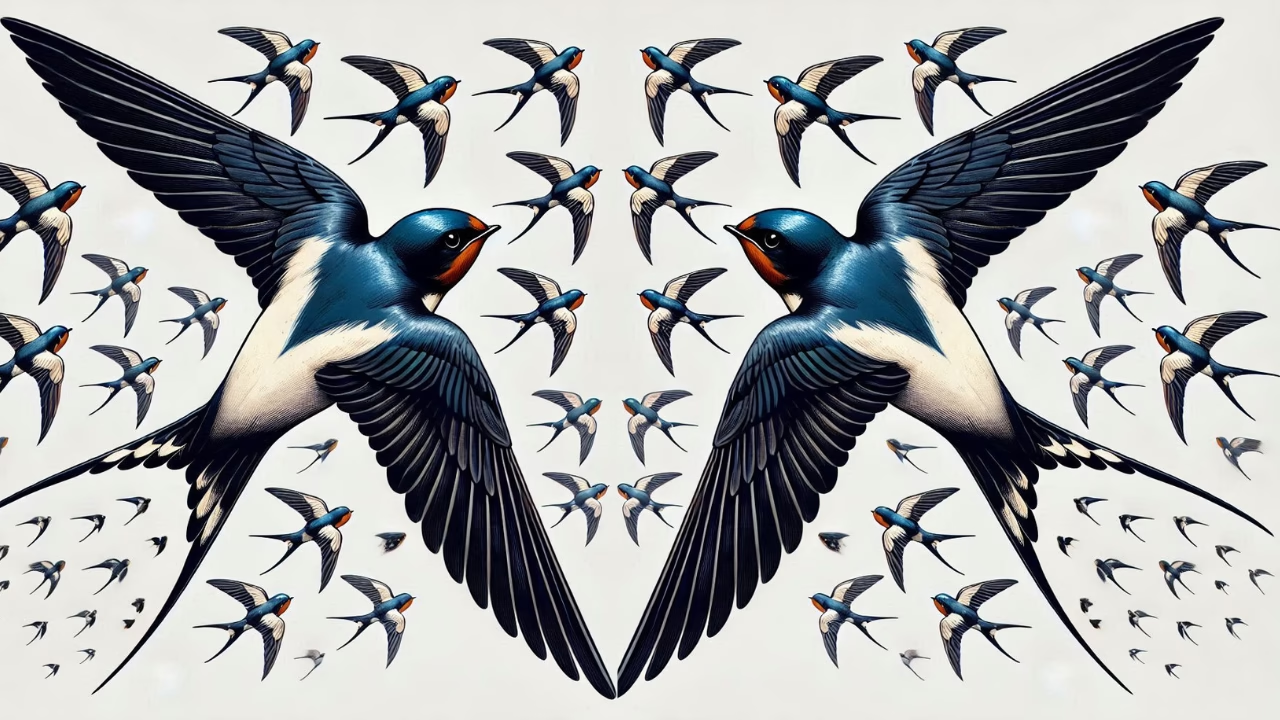What is a Swallow Bird?
Swallow bird is a small to medium-sized passerine bird belonging to the family Hirundinidae. There exist almost 90 species of birds that fall in this family and can be found on every continent except Antarctica. The principal feature related to swallows is their ability to feed while they are flying.
They have long-pointed wings and a distinctively forked tail which allows them to make very sharp turns in the air and are birds of small size that are agile and known for their fabulous flight and migration. It is one of the many birds that symbolize hope, freedom, and new life in different cultures.
The word “swallow” comes from the Old English “swealwe,” taken to describe their particular style of flying, dipping, and then gliding, as if gulping or swallowing the air. The most common one known is the barn swallow (Hirund o rustica), generally widespread in many parts.
Swallows are usually met in open spaces where the bird looks for insects it pursues in flight. These birds are social and nest in colonies while migrating long distances between breeding grounds and wintering grounds.
In this article, we will be exploring the definitions of swallows, describing some characteristics of the physical attributes found in this amazing family, along with diversity.
Definition and Classification of Swallows
Swallows fall within the order of Passeriformes, which is the most massive order of birds. However, they have an exact position within that very order because they fall into the family Hirundinidae. Then, the family is differentiated into two subfamilies, namely Hirundininae stands for ‘true swallows’, and Pseudo-chelidoninae as ‘showings’. Classification has tended to prove it with developed characters in terms of supporting aerial feeding habits.
What is the Swallow Bird in Physical Terms?

The swallows are aerodynamic bodies that are built to travel at speed and to fly agilely. It possesses the following:
- Size and Weight: Swallows generally measure about 5 to 8 inches long and weigh about 0.5 to 1 ounce.
- Distinctive Features: Plumage is glossy blue or green on the upper parts, with lighter underparts. The barn swallow has a blue back with a reddish throat and pale underparts.
- Wing Span: Swallows have long wings that can stretch to 12 inches in length and, of course, are handy in gliding nicely around insects.
- Tail shape: Probably the most distinguishing feature is the forked tail, which helps it make sharp turns.
Species differences
There are quite many swallow species, and they differ in the following ways:
- Barn Swallow (Hirundo rustica): Long, deeply forked tail and long wings. Upper body dramatically blue, reddish throat.
- Tree Swallow (Tachycineta bicolor): The tail is shorter than the barn swallow and the body is more rounded with iridescent greenish-blue upper parts.
- Cliff Swallow (Petrochelidon pyrrhonota): Square tail, plus pale underside; build mud nest under eaves or cliffs.
These differences show their adaptation to other environments and ways of living. Classification within the Hirundinidae family points to unique adaptations toward aerial feeding. The range of physical features varies between species, and swallows have remained a source of attraction for bird watchers and nature enthusiasts. Their role in ecosystems calls for the preservation of these agile flyers.
Swallow Bird Habitat and Nesting
Where Do Swallows Live?
Swallows are bird species that love to survive in different habitats. They thrive in open grasslands and woodlands in urban centers. These birds prefer settings where they easily catch the flying insects, which become their favorite food. Generally, one finds swallows near freshwater bodies such as lakes and rivers, considering the area provides a full population of insects.
Geographically, the swallows have a wide distribution. They are found on all continents except Antarctica. Such global presence is attributed to the fact that they can survive in any climate and habitat. In North America, for instance, the swallow migrates south during winter, while it returns during springtime to breed.
How do Swallows Build Their Nest?
The nests built by swallows show differences. Usually, mud is their common construction material. Pre-construction begins with getting their raw material, mud that one or both of the adults usually obtain from such nearby locations as ponds, and puddles. Adding their materials is the grass and so the plants to make an uncomplicated structure.
This varied between species but a variety commonly seen are:
- Mud: It is commonly used in structural build-up.
- Grass and Feathers: These materials line the inside of the nest for comfort.
- Swallows prefer particular nesting locations. Common sites include:
- Under Eaves: Many swallows build their nests on the ledges of buildings, barns, and bridges.
- Cliffs and Caves: Some species, like the Cliff Swallow, prefer vertical surfaces where they can attach their nests securely.
What Do Swallow Birds Eat?
Swallows are mainly insectivores. That means they are flying predators and catch their food during flight. Their main sources of food are: Insecta Flying-Some common insects they consume:
- Flies: Such as house flies and horse flies.
- Beetles: Very frequently eaten.
- Wasps and Bees: They will sometimes eat them.
- Flying Ants: Only when flying.
- True Bugs: The family includes stink bugs and leafhoppers.
- Moths: Most importantly consumed during summer seasons.
- Dragonflies and Grasshoppers: These are bigger insects, and provide enough nutrients.
Apart from insects, swallows sometimes eat tiny invertebrates like spiders and snails. Curiously, some species of swallows have been known to eat small pebbles or shells. This helps in digestion by grinding food in their gizzards. While insects make up most of their diet, some swallows, like Tree Swallows, may eat small amounts of berries and seeds during winter when insects are scarce.
Swallows are fascinating birds with unique habitats and nesting behaviors. They thrive in various environments and play an essential role in controlling insect populations. By providing suitable nesting sites and protecting their habitats, we can support swallow populations in our communities.
Swallow Bird Sounds
What Does a Swallow Bird Sound Like?
Swallows are recognized by their unique vocalizations, which they use for different purposes. Their sounds include chirps, whistles, and gurgles, each with a meaning. For example, swallows use these calls to communicate, mate, and mark territories.
Vocalizations:
- Chirps: These are short and sharp sounds that swallows make to communicate with each other. They often signal excitement or alertness.
- Calls: Swallows have several calls that might mean one thing or another. The rapid series of chirps may be used in the defense of their nests against intruders.
These sounds serve multiple purposes. They help swallows identify one another, form pair bonds during breeding season, and keep track of each other in their flocks. Additionally, vocalizations may serve as alarms to alert other birds to potential predators.
Swallow Bird Behavior
Social Structure and Group Behavior
Swallows have some interesting social behaviors. Swallows mostly nest in colonies rather than solitary nesting. The number provides them with safety in numbers from predators as well as social interaction for the birds.
- Nesting Habits: The majority of swallows favor nesting in colonies. Such as barn swallows nest under the eaves of buildings or cliffs, and thus, they form very large colonies. However, the species may nest alone in case the available sites are scarce.
- Flocking Behavior During Migration: Swallows also tend to flock during migration. During migration, they tend to form very large groups that help them travel and find food sources efficiently.
Swallow Bird Migration Patterns

Where Do Swallows Migrate?
Swallows have rather long migration routes. Typically, they migrate to southern regions for the winter, where it is relatively warm and food plentiful.
- Migratory Routes Summary: Within North America, a great deal of swallows migrate from Canadian breeding grounds and other locations in the northern U.S. to Mexico and Central America during the winter months.
- Seasonal Migration Habits: During migration, swallows can cover thousands of miles. For instance, barn swallows often migrate to South America during the colder months before returning to North America in spring.
What is the Flying speed of a swallow Bird?
Their speed, as with the rest, swallows are known to fly swiftly and agilely. During normal flight, they typically go at 25-30 mph (40-48 km/h). Still, in pursuit of prey or trying to avoid predators, they can move at higher speeds of up to 35 mph (56 km/h) or even 50 mph (80 km/h).
Their streamlined bodies, long-pointed wings, and bifurcated tails endow them with marvelous acrobatic skills. All this enables them to make sharp turns, dive downwards, and change direction within their insect prey in a lightning-fast manner.
Their calls and singing are very important in all aspects of communication and sexual activity, while the movements of migration are evidence of their adaptability to changing environments. Appreciating these aspects will bring further beauty and importance to this agile flyer in our ecosystems.
Baby Swallow Birds

What Is a Baby Swallow?
Baby swallows are so cute; one becomes fascinated by the way these small birds are formed. As newly born, the birds have their body entirely covered in soft, fluffy down, and shining eyes. Generally, the juvenile swallow birds have all characteristics that look close to those of the adults except some minor ones. First, the pale reddish buff color of its face is much lighter than that found on adult birds, which can be deep red. Besides, they have relatively short tails and non-glossy upperparts.
Both parents take care of the young. Once the eggs have hatched, both male and female swallows continue feeding the nestlings on different turns. They feed them mostly a diet of insects caught in the air. The young swallows get ready to fledge between 18 to 23 days in the nest as they start leaving the nest one by one. During the breeding season, they grow their abilities to fly fast.
How to Remove Swallow Bird Nests
Guidelines to Remove Nest
If you want to remove swallow nests from your property, you need to follow the legal guidelines and consider using humane methods. In many regions, swallows are protected by law, especially when they are in the nesting season. Hence, if you remove the nests without getting proper permission, it can become illegal.
- Legal Factors: There is a first and foremost need to note the local wildlife policies on swallow nests. Possibly, there is an illegal activity of disturbing an active nest or harming birds.
- Humane Deterrents to Nesting Swallows: If you have a desire to keep the swallows away from breeding on your property, then it is possible by the following humane deterrents:
- Install a physical barrier in the form of netting or spikes where swallows normally build their nests.
- Use reflective materials or decoys that will deter the swallows from approaching.
Why Would a Bird Swallow Gravel or Small Stones?
Understanding Grit Consumption
There are instances where swallows may swallow small pebbles or gravel, which would seem unusual at first. But this is not done randomly. It serves a purpose.
- Swallowing Gravel or Stones as a Means to Digest: The swallow swallows small stones to aid digestion. Birds grind their food without the benefit of teeth; therefore, they use grit in their gizzards to break up some of the harder items into edible parts, such as when they eat insects.
- Importance in Facilitating the Grinding Process in the Gizzard: The gizzard is a muscular part of a bird’s stomach that acts to grind food into smaller pieces. Gravel swallowed by the swallow functions as small grinding stones and helps mash up the insects they eat, making their digestion easier.
How to Invite Swallows to Your Backyard
Creating an Ideal Setting
If you intend to attract swallows into your yard, then this will require a welcoming environment in it. These are some tips:
Building Swallow-Friendly Habits
- Have open spaces, allowing the swallow to be able to chase flying insects easily.
- Keep water readily available in places such as small ponds or birdbaths close by.
Why Birdhouses Especially Swallow Nesting Are Important
Installing swallow-specific birdhouses will attract them to nest in your yard. They should resemble the natural nesting sites and should be installed high enough so they are not accessible to predators.
The entrance hole should be the right size for swallows, and there should be adequate ventilation inside the house.
By following these guidelines and knowing the behaviors of baby swallows, one will appreciate these beautiful birds more and provide them with a safe environment to thrive.
Conclusion
Swallows play an important role in our ecosystems. Skilled aerial insectivores, can be of importance to both agricultural and natural environments when maintaining balance. With vast quantities of flying insects, these birds are involved in the pest management of farms and gardens, and farmers/gardeners reap benefits for that. Swallows often serve as an indicator that a particular ecosystem is thriving well since they love the area rich in biodiversity.
However, the swallow birds face various setbacks such as habitat destruction and declining insects because of climatic changes and pesticide use. There is a need to love these wonderful birds and try to protect their habitats. Protecting the swallow-friendly habitats will help in preserving these birds.
FAQs about Swallow Bird
-
- 1. What does a swallow bird sound like?
- Swallows make different vocalizations such as chirp and whistle. These callings are a form of communication between birds, especially in mating seasons.
- 2. Where do swallows normally build their nests?
-
- A swallow normally builds its nest under eaves, under cliffs, or other shelters with mud and plant material.
- 3. What is the food for baby swallows?
- Baby swallows feed on insects, and these are caught by their parents in flight.
- 4. Why would I want to attract swallows to my yard?
-
- You can attract swallows in your yard to help keep insects under control naturally while maintaining a lively ecosystem within your garden.
- 5. How do I make a swallow-friendly environment?
- Attract swallows by opening spaces for foraging and setting up birdhouses, especially those designed for swallows, and having sources of water nearby.

